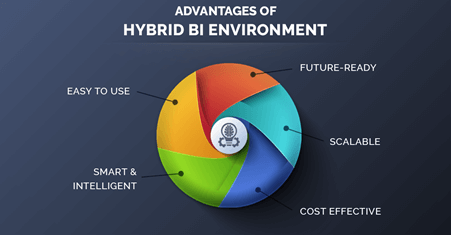Businesses have to compete and thrive in an environment where consumer habits are changing faster and customers prefer to leverage technology tools for convenience. Organizations require technology to reduce the complexities of handling business operations and seamlessly running business processes. That’s where SAP S/4HANA steps in.
S/4HANA runs exclusively on SAP HANA which is SAP’s flagship in-memory computing database and can take complete advantage of the outstanding transaction, processing, and reporting speeds native to SAP HANA, as against other slower options. It is a highly user-friendly, flexible solution from SAP that is driven by SAP Fiori-powered user interface which is popular for its simplified user experience. With S/4HANA, organizations can create bespoke, understandable business insights based on real-time data from anywhere and anytime.
If coupled with business-wide cloud adoption, SAP S/4HANA centralizes and unifies hardware and network resources for ultimate business performance. The cloud has opened up a wide platform for different software vendors to experiment and provide a range of innovative products for business use, all of which expand the vast capabilities of S/4HANA.
S/4HANA represents a revolutionary step in the world of business management software and is, therefore, most preferred by businesses as an intelligent and scalable ERP solution.

The Shift to Cloud and Using SAC
With the new release in 2020, SAP S/4HANA on-premise gained the ability to integrate SAP Analytics Cloud (SAC) for an embedded experience for business users. Real-time analytics of the operational data is one of the most important features of the new SAC. It makes available relevant reports and dashboards on the same launchpad. As a result, users need not log on to other systems.
SAC is an intuitive easy-to-use tool in the SAP portfolio delivered that meets data visualization requirements in the cloud. As a SaaS-based product, it covers the needs of data visualization, budget planning, and predictive analytics. It helps create data reports from data that can originate from a variety of sources. It captures business activities, budget forecast data, or even data from MS Excel.
SAP BusinessObjects (BO)
SAP BusinessObjects or SAP BO, popularly known as BOBJ, is an enterprise software solution that specializes in reporting and analytical business intelligence functions that help business users to find data, conduct analytics, and generate reports. SAP BusinessObjects BI Suite is an on-premise BI platform that provides real-time data access that allows its users to operate with data as a self-service BI system.
BusinessObjects offers various capabilities such as ad hoc reports, interactive dashboards, and data visualization with in-built instruments for business users that allow for creating visualizations via a drag-and-drop interface. It can be integrated with many other products including additional analytical instruments, data sources, and ERP applications with the help of APIs.
Does SAC Score Over SAP BOBJ?
While evaluating all of SAP BI products, it is important to remember that the HANA database provides real-time data access, which guarantees quick processing of large amounts of data and small response time. This database is also compatible with different database management systems thereby making data integration a lot easier within the whole organization. The SAP BO BI apps make use of the drag-and-drop functionality to help users discover and analyze data from various sources by integrating the data from different back-end sources.
- SAP Analytics Cloud is provided as software-as-a-service, a cloud-based intelligent solution with ML and embedded AI technology that delivers the integration of BI, enterprise planning, and augmented analytics in a single, simple analytics solution.
- With augmented analytics at its core, SAP Analytics Cloud helps all stakeholders in an organization make informed decisions without IT intervention or data science training.
- Everyday business users can harness newly accessible artificial intelligence and machine learning mechanisms to obtain deeper insights.
Even users without special data mining or visualization skills can easily discover and display patterns and trends previously hidden from view. Analytics are conversational, automated, and predictive, and help users arrive at smarter decisions faster.

- A hybrid BI environment helps create future-ready scalable and intelligent enterprises.
- With its extensive experience in implementing BI tools for businesses across the globe, Gemini Consulting & Services is best placed to help you adopt the right tools for your organization. Talk to one of our experts to find out how your business can take advantage of a hybrid BI environment.
- The advantage of cloud technology includes reduced cost, flexibility and scalability. It makes it possible for enterprise-wide operations to take advantage of cutting-edge digital technologies like machine learning and artificial intelligence to obtain faster and easier business insights. It is therefore imperative that businesses move to the cloud as soon as they can, and the ability to integrate on-premise BusinessObjects BI with Analytics Cloud is a smart solution to do just that.
- SAP BusinessObjects provides the advantage of safeguarding business data, which is often the first consideration when choosing an enterprise data management or analytics platform. With a hybrid BO-SAC architecture, both SAC and BO can be hosted on a secure private cloud and using a Live Data Connect setup, no data leaves the on-premise network. While only the metadata gets uploaded, the entire data processing is done on the browser.
- The key here is to think of a slow move from on-premise BO to SAC and not as a single leap. While a hybrid setup is likely to cost more in total than maintaining the existing system – in the long run, it allows both more efficient use of budget for the on-premise licensing and maintenance. All of this while giving businesses the added value of analytics in a cloud-managed upgraded environment with no hardware to pay for and keep up, and automatic regular feature updates. It is important to note that these feature updates are closing the functionality gaps between SAC and BO.
- In short- Being able to use SAP BusinessObjects and SAP Analytics Cloud simultaneously allows businesses to use their data on a modern interface with predictive graphics, explore data and use other capabilities such as augmented and predictive analytics, all of this while keeping the data on-premise. Remember that this approach still allows businesses to do operational reporting, advanced scheduling, and distribution, and while being able to leverage years of investment in the semantic layer.



